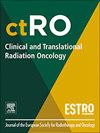Efficacy and safety of the pudendal nerve block as a component of multimodal analgesia for cervical brachytherapy
IF 2.7
3区 医学
Q3 ONCOLOGY
引用次数: 0
Abstract
Introduction
Whilst an essential component of curative management, cervical brachytherapy is associated with considerable pain and discomfort, with analgesic protocols varying between institutions. We present the first series on adjunctive pudendal nerve block (PNB) in addition to routine anaesthesia.
Methods
Retrospective review of patients receiving brachytherapy for cervical malignancies across two time periods, correlating to the institutional introduction of PNB. Technically, bilateral PNB was performed using 1 % ropivacaine under general anaesthesia and intravenous patient-controlled analgesia (PCA) was used post-operatively. Median pain scores (11-point numeric rating scale), acceptability of pain (<20 % of recorded scores ≥ 4), opioid requirement and adverse events are reported. Intracavitary with or without interstitial brachytherapy was performed as per EMBRACE-2 protocol.
Results
78 patients receiving 149 brachytherapy episodes were included, of which 95 episodes (64%) utilised PNB. 48% of cases required interstitial needles in both cohorts, with no significant differences in demographics.
Median pain scores were lower in the PNB cohort (1 vs. 2.5; p = 0.003). PNB was associated with less episodes of unacceptable pain, as defined above (33 % vs. 63 %; p < 0.001). This benefit was sustained on binomial logistic regression, including such factors as number of interstitial needles, baseline opioid use and applicator model choice.
PNB use was also associated with reduced opioid requirement via PCA (p < 0.001) and there were no differences in the incidence of hypotension, respiratory depression or nausea between cohorts.
Conclusions
PNB is an effective and safe adjunct to general anaesthesia and intravenous PCA for cervical brachytherapy, with improved pain and reduced opioid requirements. We advocate for routine use of PNB in addition to multimodal analgesic regimens.
阴部神经阻滞作为颈部近距离放射治疗中多模式镇痛的有效性和安全性
虽然是治疗管理的重要组成部分,但颈椎近距离放射治疗与相当大的疼痛和不适有关,不同机构的镇痛方案不同。我们提出了第一个系列的辅助阴部神经阻滞(PNB)除了常规麻醉。方法回顾性分析两个时期接受宫颈恶性肿瘤近距离放疗的患者,这两个时期与PNB的制度引入有关。技术上,双侧PNB在全身麻醉下使用1%罗哌卡因,术后使用静脉自控镇痛(PCA)。报告了中位疼痛评分(11分数值评定量表)、疼痛可接受性(<; 20%的记录评分≥4)、阿片类药物需求和不良事件。腔内伴或不伴间质近距离治疗均按照恩布拉-2方案进行。结果78例患者接受149次近距离放疗,其中95次(64%)使用PNB。在两个队列中,48%的病例需要间质针头,在人口统计学上没有显著差异。PNB组的中位疼痛评分较低(1比2.5;p = 0.003)。如上所述,PNB与不可接受疼痛发作次数较少相关(33%对63%;p & lt;0.001)。在二项逻辑回归中,包括间隙针数量、基线阿片类药物使用和涂抹器模型选择等因素,这种益处得到了持续的维持。PNB的使用也与通过PCA减少阿片类药物需求相关(p <;0.001),在低血压、呼吸抑制或恶心的发生率上各组间没有差异。结论spnb是近距离颈椎病全麻和静脉PCA治疗的有效、安全辅助,可改善疼痛,减少阿片类药物的需要量。我们提倡在多模式镇痛方案之外常规使用PNB。
本文章由计算机程序翻译,如有差异,请以英文原文为准。
求助全文
约1分钟内获得全文
求助全文
来源期刊

Clinical and Translational Radiation Oncology
Medicine-Radiology, Nuclear Medicine and Imaging
CiteScore
5.30
自引率
3.20%
发文量
114
审稿时长
40 days
 求助内容:
求助内容: 应助结果提醒方式:
应助结果提醒方式:


